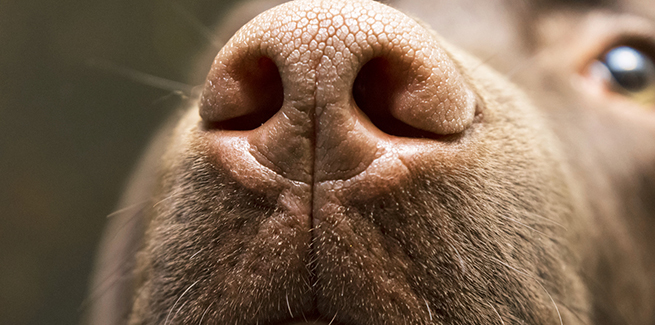Dogs are being trained to sniff out COVID-19. But who will test the testers?

Researchers are training dogs to detect SARS-CoV-2 in humans.
But the US Centers for Disease Control and Prevention (CDC) says we’re supposed to practice social distancing with dogs . . . to keep them away from humans who might have SARS-CoV-2.
So how exactly is this going to work?
Last week, researchers at the University of Pennsylvania Matthew J. Ryan Veterinary Hospital (Penn Vet) announced a pilot training program to teach Labrador retrievers to sniff out SARS-CoV-2 in humans.
Dogs who can detect the scent of the novel coronavirus could identify infection in asymptomatic people and could play an important role in wrangling the disease as people return to work and social distancing restrictions are relaxed, Penn Vet representatives said in a statement.
Using dogs to sniff out disease isn’t a new idea. One study in 2004 found that dogs could distinguish patients with bladder cancer based on the smell of their urine. In a 2006 study, dogs were able to detect lung cancer by smelling patients’ breath.
If the pilot program at Penn Vet works, the dogs could provide a noninvasive, four-legged method to screen people in airports, businesses, or hospitals—places where testing poses particular challenges—without depleting limited human testing resources.
But could exposure to COVID-19 pose a threat to the dogs?
In March, a pet dog in Hong Kong tested positive for COVID-19, and experts suspect that he caught the disease from his infected owner. Two weeks ago, a dog in North Carolina tested positive for COVID-19 after catching it from his infected owners.
NEWStat asked Jason W. Stull, VMD, MPVM, PhD, DACVPM, assistant professor of Veterinary Preventive Medicine at The Ohio State University College of Veterinary Medicine, and chair of AAHA’s Infection Control, Prevention, and Biosecurity Guidelines Task Force, about the risk.
“We know dogs can get infected with the SARS-CoV-2 virus [and] although this seems to [be uncommon], it’s important to point out that overall, only a small number of dogs from households with people with COVID have been tested to date. From various experiments, it appears it would be unlikely for dogs to be able to spread the virus if they got infected,” Stull said.
Stull was careful to point out that unlikely doesn’t mean never, or that it can’t happen.
“There is clearly an important need to be able to quickly detect people infected with the SARS-CoV-2 virus, and it’s possible trained dogs may be able to assist on that front,” Stull added. “However, it will be very important for the researchers in this trial to carefully follow the dogs in the study for signs of disease and test them for infection to ensure this can be done in a safe way.”
No worries on that front—turns out the researchers have it covered.
NEWStat contacted Cynthia Otto, DVM, PhD, DACVECC, to ask about Stull’s concerns. Otto, the director of the Working Dog Center at Penn Vet, is leading the study.
Otto said Penn Vet shares the concern about keeping the dogs (and handlers) safe during this important work: “We’re approaching this with the best scientific information and concern for the welfare of the dogs.”
Specifically, Otto said the researchers are basing their safety protocols on the latest science-based guidance from the American Veterinary Medical Association and the CDC.
“According to the CDC website at this time, there is no evidence that animals play a significant role in spreading the virus that causes COVID-19,” Otto told NEWStat. “That said, we’re taking all precautions to minimize risk and monitor for exposure.”
Otto also pointed out that the virus used in the trial is inactive, and the samples are contained in training-aid delivery devices that prevent any access to them. “So there’s no chance that the dogs or humans will be exposed.”
And after the trial is over?
Otto said that if the trial achieves proof of concept and the dogs begin screening people in a real-world setting, then both dogs and handlers will be exposed to people who will have the virus.
“To mitigate that risk, we’ll be maintaining detection at the furthest possible distance that’s still accurate,” Otto said. “We’ll be monitoring the dogs for signs of exposure, testing them routinely for the virus and also antibodies to the virus, and we’ll be evaluating decontamination procedures (or implementing proven decontamination procedures as validated by scientific studies) to ensure that they’re not carrying the virus.”
In addition, Otto said, the handlers will all be equipped with full personal protective gear and people being screened will be wearing face masks.
Trained dogs could be ready to start sniffing out COVID-19 in humans by July—as safely as possible.
Photo credit: © iStock/bigtunaonline



